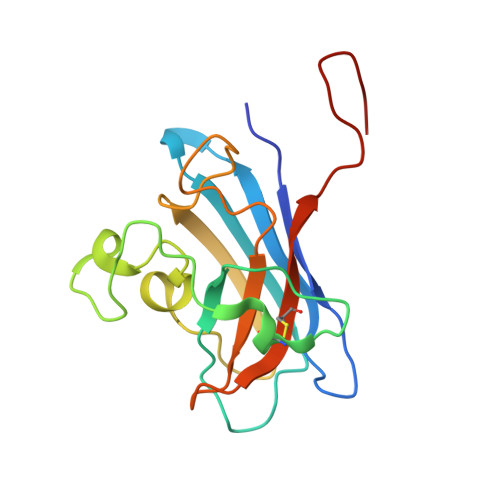Candida albicans SOD5 represents the prototype of an unprecedented class of Cu-only superoxide dismutases required for pathogen defense.
Gleason, J.E., Galaleldeen, A., Peterson, R.L., Taylor, A.B., Holloway, S.P., Waninger-Saroni, J., Cormack, B.P., Cabelli, D.E., Hart, P.J., Culotta, V.C.(2014) Proc Natl Acad Sci U S A 111: 5866-5871
- PubMed: 24711423
- DOI: https://doi.org/10.1073/pnas.1400137111
- Primary Citation of Related Structures:
4N3T, 4N3U - PubMed Abstract:
The human fungal pathogens Candida albicans and Histoplasma capsulatum have been reported to protect against the oxidative burst of host innate immune cells using a family of extracellular proteins with similarity to Cu/Zn superoxide dismutase 1 (SOD1). We report here that these molecules are widespread throughout fungi and deviate from canonical SOD1 at the primary, tertiary, and quaternary levels. The structure of C. albicans SOD5 reveals that although the β-barrel of Cu/Zn SODs is largely preserved, SOD5 is a monomeric copper protein that lacks a zinc-binding site and is missing the electrostatic loop element proposed to promote catalysis through superoxide guidance. Without an electrostatic loop, the copper site of SOD5 is not recessed and is readily accessible to bulk solvent. Despite these structural deviations, SOD5 has the capacity to disproportionate superoxide with kinetics that approach diffusion limits, similar to those of canonical SOD1. In cultures of C. albicans, SOD5 is secreted in a disulfide-oxidized form and apo-pools of secreted SOD5 can readily capture extracellular copper for rapid induction of enzyme activity. We suggest that the unusual attributes of SOD5-like fungal proteins, including the absence of zinc and an open active site that readily captures extracellular copper, make these SODs well suited to meet challenges in zinc and copper availability at the host-pathogen interface.
Organizational Affiliation:
Department of Biochemistry and Molecular Biology, Johns Hopkins University Bloomberg School of Public Health, Baltimore, MD 21205.
















